- Tips to Self-Edit Your Dissertation
- Guide to Essay Editing: Methods, Tips, & Examples
- Journal Article Proofreading: Process, Cost, & Checklist
- The A–Z of Dissertation Editing: Standard Rates & Involved Steps
- Research Paper Editing | Guide to a Perfect Research Paper
- Dissertation Proofreading | Definition & Standard Rates
- Thesis Proofreading | Definition, Importance & Standard Pricing
- Research Paper Proofreading | Definition, Significance & Standard Rates
- Essay Proofreading | Options, Cost & Checklist
- Top 10 Paper Editing Services of 2024 (Costs & Features)
- Top 10 Essay Checkers in 2024 (Free & Paid)
- Top 10 AI Proofreaders to Perfect Your Writing in 2024
- Top 10 English Correctors to Perfect Your Text in 2024
- 10 Advanced AI Text Editors to Transform Writing in 2024
- Personal Statement Editing Services: Craft a Winning Essay
- Top 10 Academic Proofreading Services & How They Help
- College Essay Review: A Step-by-Step Guide (With Examples)
- Top 10 College Essay Review Services: Pricing and Benefits
- How to Edit a College Admission Essay (8-Step Guide)
- Improve Academic Writing: Types, Tips, Examples, Services
- How to Use AI to Write Research Papers: A Step-by-Step Guide
- How to Write an Assignment: A Step-by-Step Guide for Students
- AI Proofreading Services: Meaning, Benefits & Best Tools
- 10 Best Proofreading Services Online for All in 2025
- Research Paper Outline: Free Templates & Examples to Guide You
- How to Write a Research Paper: A Step-by-Step Guide
- How to Write a Lab Report: Examples from Academic Editors
- Research Methodology Guide: Writing Tips, Types, & Examples
- The 10 Best Essential Resources for Academic Research
- 100+ Useful ChatGPT Prompts for Thesis Writing in 2024
- Best ChatGPT Prompts for Academic Writing (100+ Prompts!)
- Sampling Methods Guide: Types, Strategies, and Examples
- Independent vs. Dependent Variables | Meaning & Examples
- Top 10 AI Tools for Research in 2024 (Fast & Efficient!)
- Understanding Verbatim Plagiarism: Copy, Paste, Regret
- What Is a Journal Article and How to Write a Journal Article
- How to Use AI to Write Research Papers: A Step-by-Step Guide
- Difference Between Paper Editing and Peer Review
- How to Handle Journal Rejection: Essential Tips
- Editing and Proofreading Academic Papers: A Short Guide
- How to Carry Out Secondary Research
- The Results Section of a Dissertation
- Final Checklist: Is My Article Ready for Submitting to Journals?
- Types of Research Articles to Boost Your Research Profile
- 8 Types of Peer Review Processes You Should Know
- How does LaTeX based proofreading work?
- How to Improve Your Scientific Writing: A Short Guide
- Chicago Title, Cover Page & Body | Paper Format Guidelines
- How to Write a Thesis Statement: Examples & Tips
- Chicago Style Citation: Quick Guide & Examples
- Research Paper Outline: Free Templates & Examples to Guide You
- The A-Z Of Publishing Your Article in A Journal
- What is Journal Article Editing? 3 Reasons You Need It
- 5 Effective Personal Statement Examples & Templates
- How to Cite a Book in APA Style | Format & Examples
- How to Start a Research Paper | Step-by-step Guide
- APA Citations Made Easy with Our Concise Guide for 2024
- A Step-by-Step Guide to APA Formatting Style (7th Edition)
- Academic Writing in 2024: 5 Key Dos & Don’ts + Examples
- How to Write a Lab Report: Examples from Academic Editors
- What Are the Standard Book Sizes for Publishing Your Book?
- MLA Works Cited Page: Quick Tips & Examples
- 2024’s Top 10 Thesis Statement Generators (Free Included!)
- Top 10 Title Page Generators for Students in 2024
- What Is an Open Access Journal? 10 Myths Busted!
- Primary vs. Secondary Sources: Definition, Types & Examples
- How To Write a College Admissions Essay That Stands Out
- How to Write a Dissertation & Thesis Conclusion (+ Examples)
- APA Journal Citation: 7 Types, In-Text Rules, & Examples
- What Is Predatory Publishing and How to Avoid It!
- Independent vs. Dependent Variables | Meaning & Examples
- How to Write a Strong Dissertation & Thesis Introduction
- How to Cite a Book in MLA Format (9th Edition)
- How to Cite a Website in MLA Format | 9th Edition Rules
- 10 Best AI Conclusion Generators (Features & Pricing)
- Top 10 Academic Editing Services of 2024 [with Pricing]
- 100+ Writing Prompts for College Students (10+ Categories!)
- How to Create the Perfect Thesis Title Page in 2024
- What Is Accidental Plagiarism & 9 Prevention Strategies
- What Is Self-Plagiarism? (+ 7 Prevention Strategies!)
- Understanding Verbatim Plagiarism: Copy, Paste, Regret
- Improve Academic Writing: Types, Tips, Examples, Services
- What Is a Journal Article and How to Write a Journal Article
- What Is Paraphrasing Plagiarism and How to Avoid It
- 50 Best Essay Prompts for College Students in 2024
- What Is Expository Writing? Types, Examples, & 10 Tips
- Academic Research Ethics & Rules Simplified for All
- Complete Guide to MLA 9th Format
- Top 10 Online Dissertation Editing Services of 2025
- What Is Plagiarism? Meaning, Types & Examples
- Preventing Plagiarism in Your Thesis: Tips & Best Practices
- Final Submission Checklist | Dissertation & Thesis
- 7 Useful MS Word Formatting Tips for Dissertation Writing
- How to Write a MEAL Paragraph: Writing Plan Explained in Detail
- How does LaTeX based proofreading work?
- Em Dash vs. En Dash vs. Hyphen: When to Use Which
- 2024’s Top 10 Self-Help Books for Better Living
- Top 10 Paper Editing Services of 2024 (Costs & Features)
- Top 10 AI Proofreaders to Perfect Your Writing in 2024
- 100+ Useful ChatGPT Prompts for Thesis Writing in 2024
- Best ChatGPT Prompts for Academic Writing (100+ Prompts!)
- MLA Works Cited Page: Quick Tips & Examples
- 2024’s Top 10 Thesis Statement Generators (Free Included!)
- Top 10 Title Page Generators for Students in 2024
- 10 Advanced AI Text Editors to Transform Writing in 2024
- Top 10 Academic Editing Services of 2024 [with Pricing]
- The 10 Best Free Character and Word Counters of 2024
- Know Everything About How to Make an Audiobook
- How to Create the Perfect Thesis Title Page in 2024
- Top 10 Academic Proofreading Services & How They Help
- Mastering Metaphors: Definition, Types, and Examples
- 10 Best Paid & Free Citation Generators (Features & Costs)
- What Is Plagiarism? Meaning, Types & Examples
- Citing References: APA, MLA, and Chicago
- How to Cite Sources in the MLA Format
- MLA Citation Examples: Cite Essays, Websites, Movies & More
- Chicago Title, Cover Page & Body | Paper Format Guidelines
- Chicago Style Citation: Quick Guide & Examples
- Citations and References: What Are They and Why They Matter
- APA Headings & Subheadings | Formatting Guidelines & Examples
- Formatting an APA Reference Page | Template & Examples
- Research Paper Format: APA, MLA, & Chicago Style
- How to Create an MLA Title Page | Format, Steps, & Examples
- How to Create an MLA Header | Format Guidelines & Examples
- MLA Annotated Bibliography | Guidelines and Examples
- APA Website Citation (7th Edition) Guide | Format & Examples
- APA Citations Made Easy with Our Concise Guide for 2024
- APA Citation Examples: The Bible, TED Talk, PPT & More
- APA Header Format: 5 Steps & Running Head Examples
- APA Title Page Format Simplified | Examples + Free Template
- A Step-by-Step Guide to APA Formatting Style (7th Edition)
- How to Write an Abstract in MLA Format: Tips & Examples
- APA Journal Citation: 7 Types, In-Text Rules, & Examples
- 10 Best Free Plagiarism Checkers | Accurate & Reliable Tools
- 5 Reasons to Cite Your Sources Properly | Avoid Plagiarism!
- How to Cite a Book in MLA Format (9th Edition)
- How to Cite a Website in MLA Format | 9th Edition Rules
- 10 Best Paid & Free Citation Generators (Features & Costs)
- Complete Guide to MLA 9th Format
- Writing a Dissertation Proposal
- The Acknowledgments Section of a Dissertation
- The Table of Contents Page of a Dissertation
- The Introduction Chapter of a Dissertation
- The Literature Review of a Dissertation
- Tips to Self-Edit Your Dissertation
- The Results Section of a Dissertation
- Preventing Plagiarism in Your Thesis: Tips & Best Practices
- Final Submission Checklist | Dissertation & Thesis
- The Only Dissertation Toolkit You’ll Ever Need!
- 7 Useful MS Word Formatting Tips for Dissertation Writing
- 5 Thesis Writing Tips for Master Procrastinators
- A Beginner’s Guide to How to Write a Dissertation in 2024
- The 5 Things to Look for in a Dissertation Editing Service
- Top 10 Dissertation Editing & Proofreading Services
- Why is it important to add references to your thesis?
- Thesis Editing | Definition, Scope & Standard Rates
- Expert Formatting Tips on MS Word for Dissertations
- A 7-Step Guide on How to Choose a Dissertation Topic
- 350 Best Dissertation Topic Ideas for All Streams in 2024
- A Guide on How to Write an Abstract for a Research Paper
- Dissertation Defense: What to Expect and How to Prepare
- Creating a Dissertation Title Page (Examples & Templates)
- Top 10 Online Dissertation Editing Services of 2025
- Essential Research Tips for Essay Writing
- How to Write a MEAL Paragraph: Writing Plan Explained in Detail
- How to Write a Thesis Statement: Examples & Tips
- What Is a Mind Map? Free Mind Map Templates & Examples
- How to Write an Essay Outline: Free Template & Examples
- How to Write an Essay Header: MLA and APA Essay Headers
- What Is an Essay? A Comprehensive Guide to Structure and Types
- How to Write an Essay: 8 Simple Steps with Examples
- Expository Essay: Structure, Tips, and Examples
- Guide to Essay Editing: Methods, Tips, & Examples
- Narrative Essays: Structure, Tips, and Examples
- How to Write an Argumentative Essay (Examples Included)
- How to Write a Descriptive Essay | Examples and Structure
- How to Write a Conclusion for an Essay (Examples Included!)
- How to Write an Impactful Personal Statement (Examples Included)
- Literary Analysis Essay: 5 Steps to a Perfect Assignment
- How to Write a Compare and Contrast Essay: Tips & Examples
- Top 10 Essay Checkers in 2024 (Free & Paid)
- 100 Best College Essay Topics & How to Pick the Perfect One!
- College Essay Format: Tips, Examples, and Free Template
- Structure of an Essay: 5 Tips to Write an Outstanding Essay
- 10 Best AI Essay Outline Generators of 2024
- The Best Essay Graders of 2024 That You Can Use for Free!
- Top 10 Free Essay Writing Tools for Students in 2024
- Personal Statement Editing Services: Craft a Winning Essay
- College Essay Review: A Step-by-Step Guide (With Examples)
- Top 10 Best AI Essay Writing Tools in 2024
- Top 10 Essay Editing Services of 2024
- Top 10 College Essay Review Services: Pricing and Benefits
- How to Write an Assignment: A Step-by-Step Guide for Students
- The Four Main Types of Essay | Quick Summary with Examples
- How to Write an Essay Introduction | 4 Examples & Steps
Still have questions? Leave a comment

Checklist: Dissertation Proposal
Enter your email id to get the downloadable right in your inbox!

Examples: Edited Papers
Enter your email id to get the downloadable right in your inbox!
Need
Editing and
Proofreading Services?

What Is a Mind Map? Free Mind Map Templates & Examples
 Mar 01, 2023
Mar 01, 2023 5
min read
5
min read
- Tags: Academic Writing, Essay
Whether you’re writing an essay, creating a presentation, or brainstorming strategies with your team, it’s a challenge to sort ideas effectively. There’s a simple solution to this, used by students and established writers alike: mind maps! A mind map helps you organize your ideas in a systematic manner and reveals clues for you to arrange your material better.
In this article, we’ll explore what mind mapping is and learn how to make a creative map for your ideas. We’ll also take a look at some mind map examples to show you unique and innovative ways to create a mind map. But before we begin, let’s establish a mind mapping definition.
What is a mind map?
A mind map is a visual tool used for brainstorming, problem-solving, and organizing ideas. It is a diagram that starts with a central idea and branches out to related subtopics and details.
As you lay out different topics and subtopics visually, you can clearly see the connections between them. In this way, mind mapping helps you see the relationships between different ideas and understand complex topics easily. It’s time to throw away those hefty notes and make note-taking a fun activity!
Let’s see how you can use a mind map in different ways.
Why use mind maps?
Is there any advantage to mind mapping beyond the obvious joy of drawing out your thought process? It’s all very well that you avoid working like a grumpy professor, but what beyond this?
Here are some benefits of using a mind map:
- Learning becomes a stimulating process.
- Difficult topics can be simplified and easy to understand.
- You can visualize complex points to easily remember and recall dense pieces of information.
- The freedom to connect ideas without a specific order leads to creative and innovative solutions.
- You can come up with a hierarchy of points by easily differentiating between primary and secondary topics.
- The engaging act of making a mind map speeds up brainstorming and improves productivity.
- Easy collaboration allows an entire team or group to work together on a presentation or project.
Mind mapping allows you to see connections and relationships between different ideas. The process makes it easier to understand complex topics and make the right decisions. In this way, a mind map enhances your memory, comprehension, and productivity.
How to make a mind map
It’s quite easy to create a mind map. All you need is a pen and paper! If you prefer working on a laptop, there are several tools you can use, our mind map template being one of them. Scroll down and you’ll find our template.
Follow these steps to make a mind map:
1. Start with a central idea
Write down the central idea or topic in the center of a blank page. This can be your essay title, an area of research, or a problem you need to solve. Make sure you leave enough space on all sides to create a spreading map.
We’ll add a step-by-step mind map example to help you understand the process. Let’s say you had to brainstorm an essay on types of democracy. Your first step will begin at the central point.

2. Add related ideas
Think of the most important subtopics or areas of interest and arrange them around the central idea. Connect these to the main topic with lines or arrows to indicate the relationship between the two.
So for an essay mind map, the first relevant bubble will be the essay introduction, which will further lead to your thesis statement. For now, we’ll show you the second stage of mind mapping in this example:
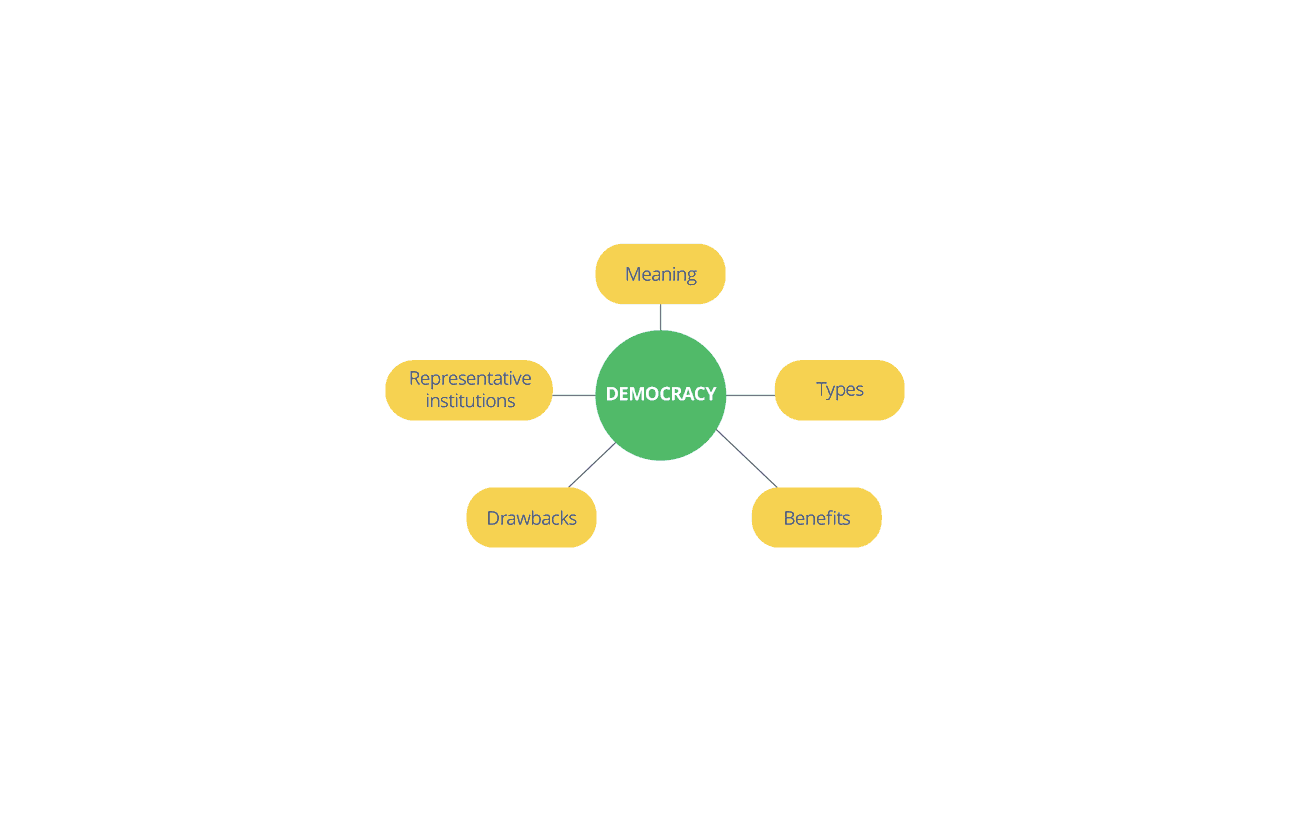
3. Create a hierarchy of ideas
Keep adding more layers until you get a spreading map that starts with your central idea and ends with specific facts, evidence, and examples. As you break down your information into smaller and smaller points, you’ll also need to denote the connections between them.
If any facts from separate subtopics are connected, draw a dotted line or arrow between them to indicate this. When you open your mind map later, all hierarchies and connections should be instantly clear to you. Come up with a system of arrows and lines to denote various types of connections between points and subpoints.
Our mind map example will outline this for you:
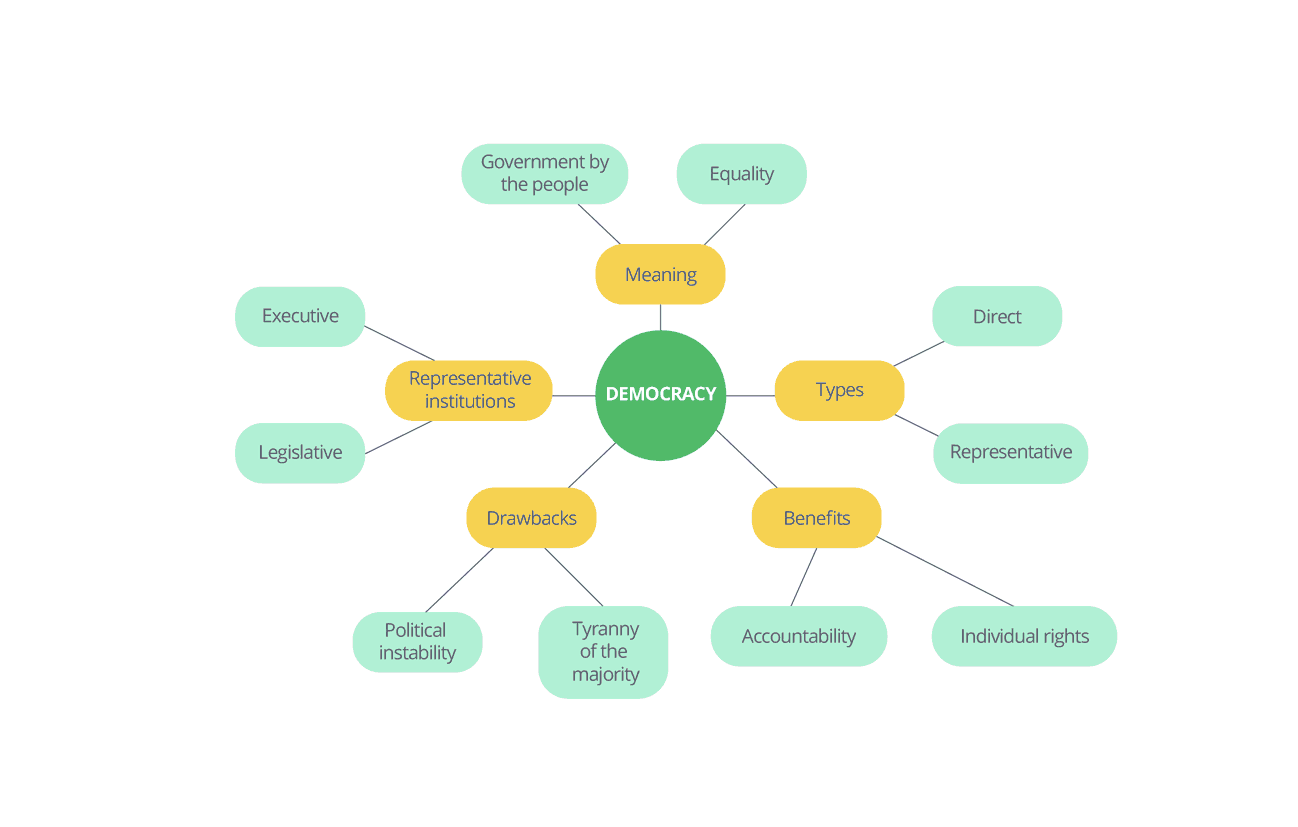
4. Review and refine the map
If you don’t have a rough essay outline in your mind, you can just focus on getting everything out on the page. After seeing the rough layout, you can decide on the final set of points and remove everything else.
So, the last step is to review your mind map and refine it until you are satisfied with the outcome. In this stage, you’ll add all the smallest details to your mind map and establish important connections through lines.
In a mind map for essay writing, the last few points will be the evidence you use to support your arguments. It’s a good idea to mark the page numbers or other citation indicators so you don’t have to go looking for them later.
Your mind map should look something like the example below:
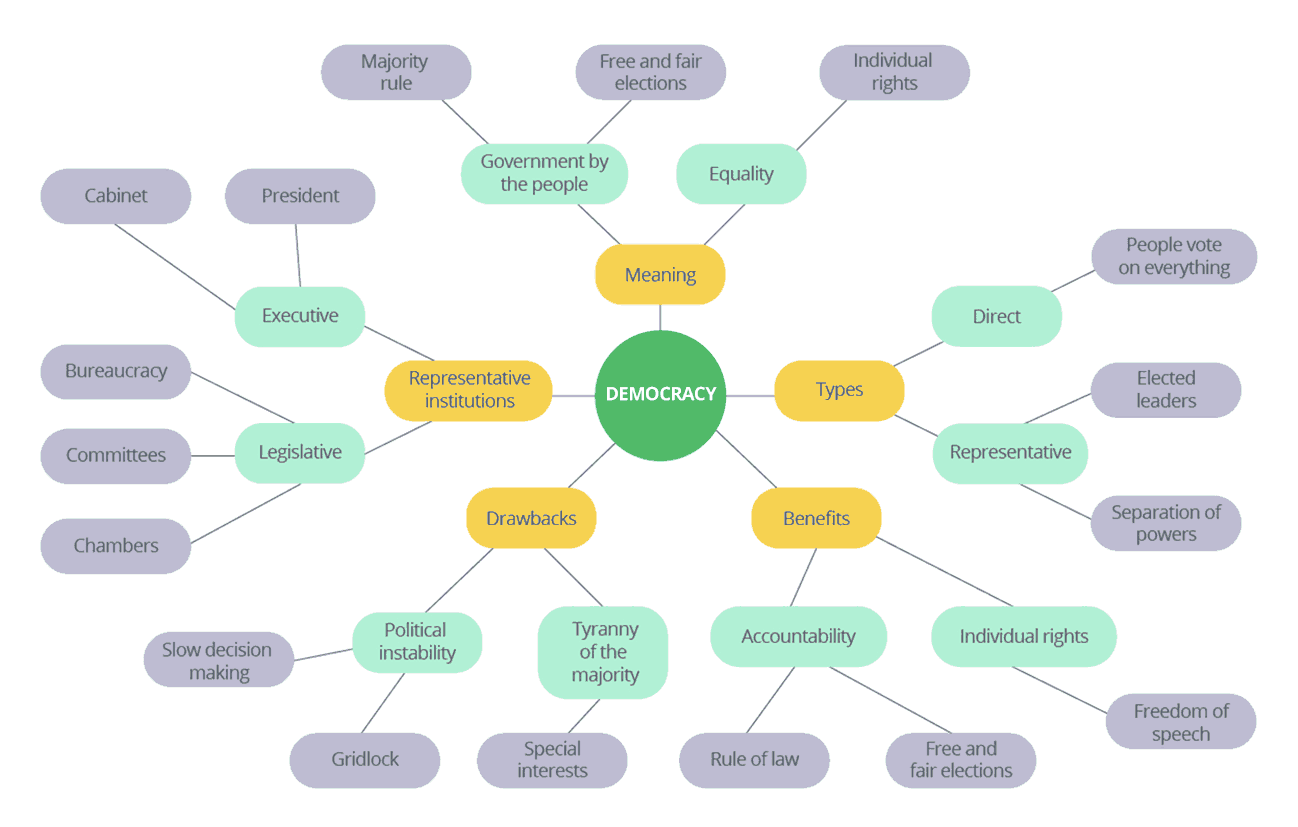
5. Add symbols and images to help you remember
While making mind maps for writing essays, it’s essential to use any techniques that can help you remember information better. A great way to ensure this is to use symbols and images to signify specific things.
You could develop a system of meanings for different signs. A star can represent important data figures, while a vertical arrow can highlight ascending or descending order. While you can utilize mind mapping tools and software to achieve this, it helps to use symbols that are personal to you. This way, it’s much easier to memorize things!
Let’s add some symbols to our mind map example and breathe life into it.
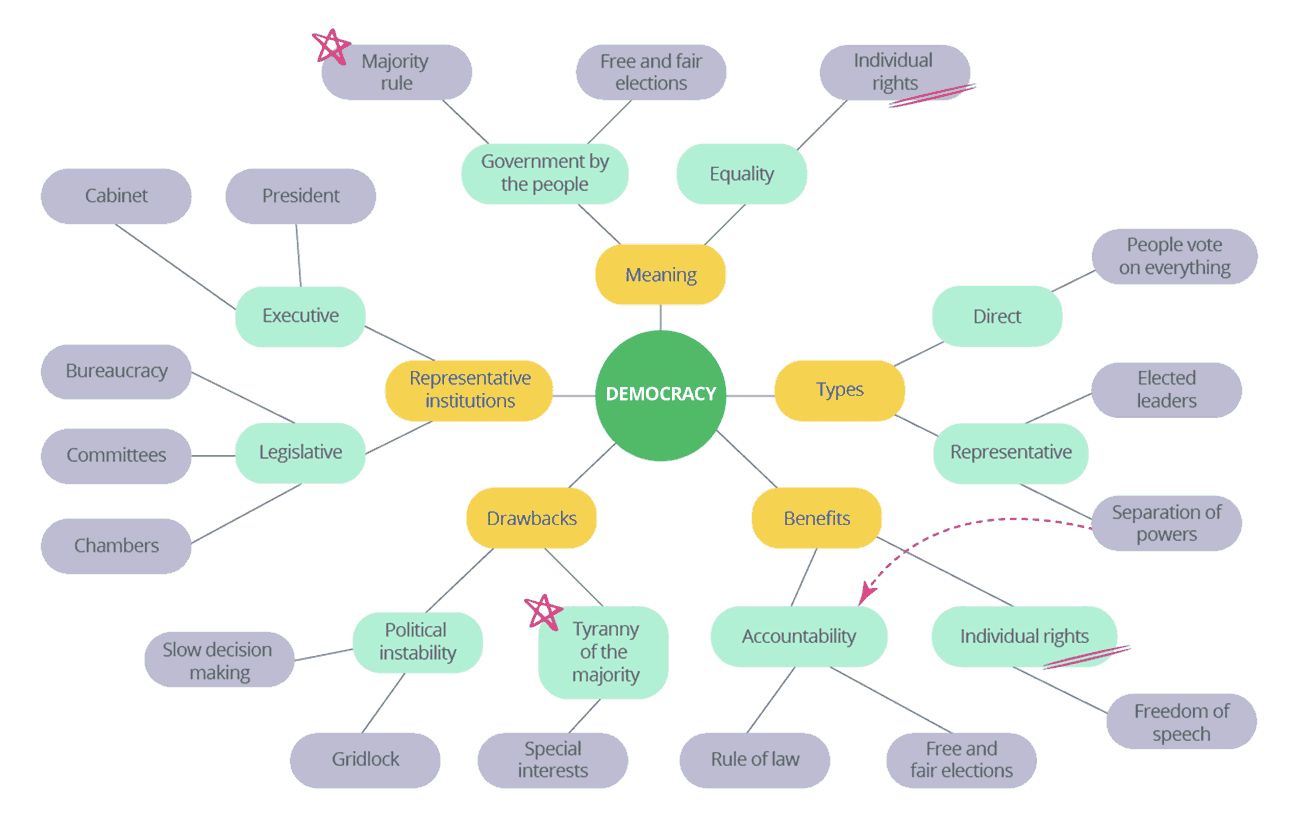
If you’d like us to add more mind mapping examples, let us know in the comments below!
Note: Keep your mind maps clean! Add only the most central points in one or two words rather than writing entire phrases or sentences. Making a cluttered and chaotic mind map serves no purpose. Keep your focus on the bigger picture and what you want to achieve through the mind map.
If you’re using the mind map for essay writing, you should know how to transfer ideas and information from your map to your essay. Knowing how to write a MEAL paragraph can help!
Free mind map templates
If you need innovative mind map ideas and templates, we have no shortage of them! Mind mapping for writing differs from mind mapping for a presentation or brainstorming session. Accordingly, mind mapping methods also differ from one another.
So, we’ve created four blank mind map templates to help you find the format that works best for you. Based on your requirements, you can choose from the mind map templates available below.
1. Basic map that radiates outward
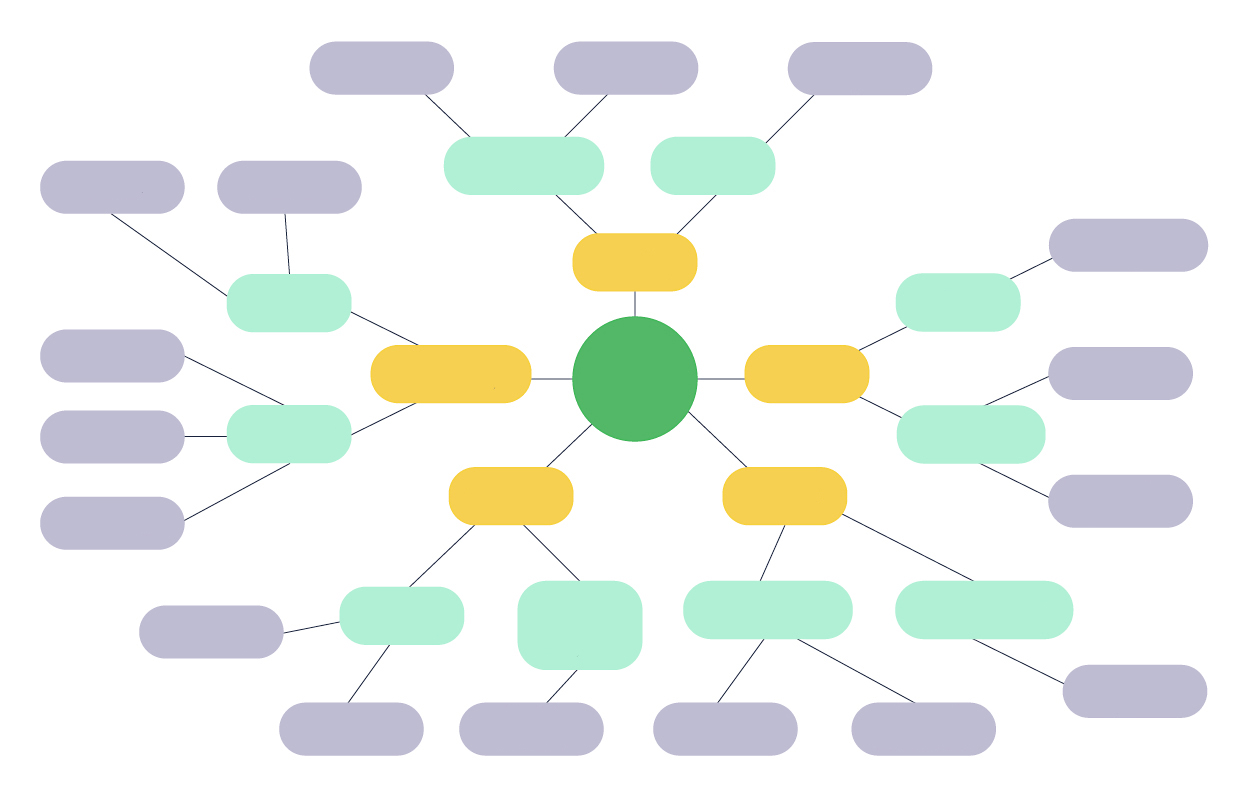
2. Template to brainstorm a topic
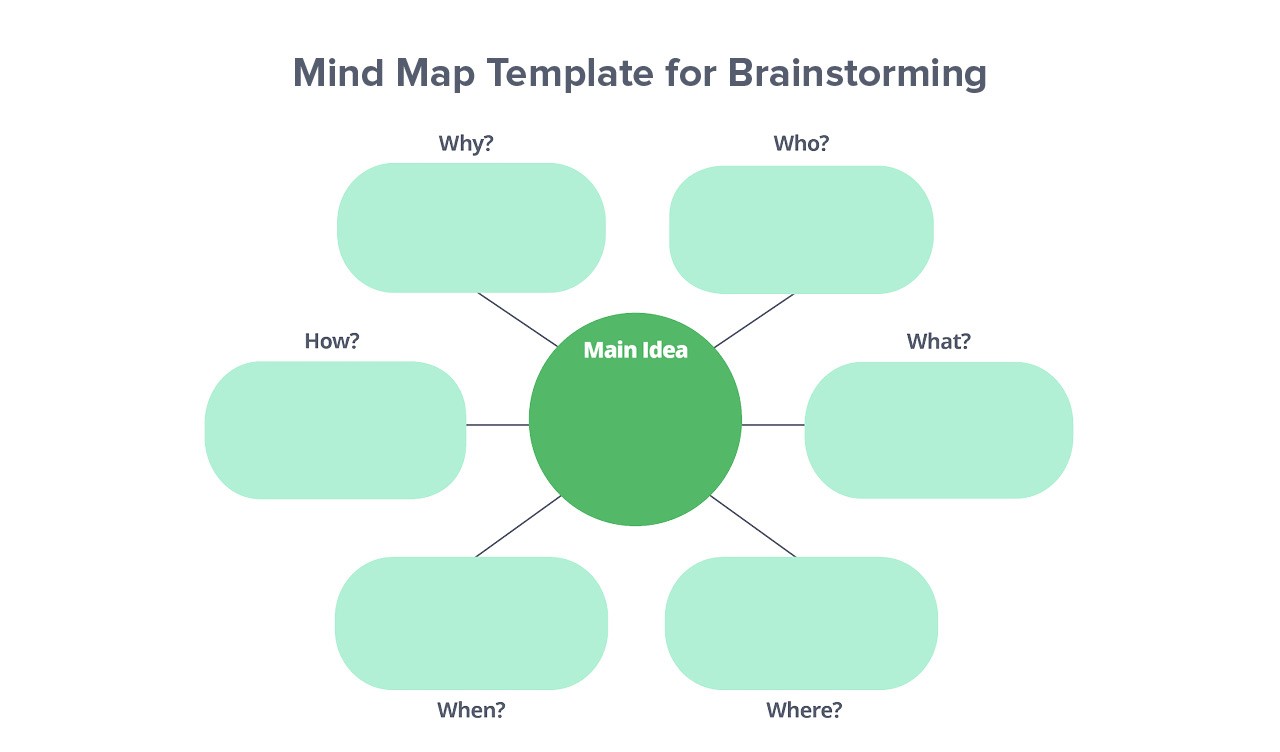
3. Mind map for writing an essay
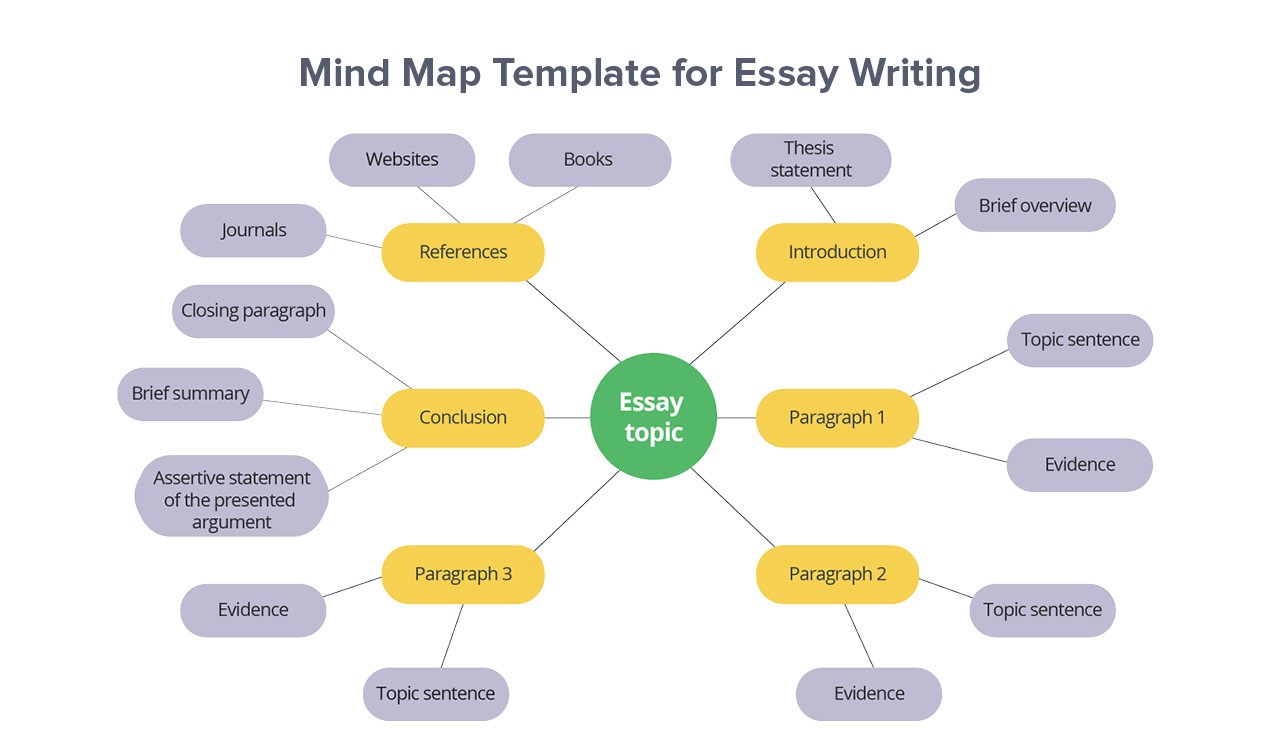
4. Mind map that uses arrows for cause-and-effect
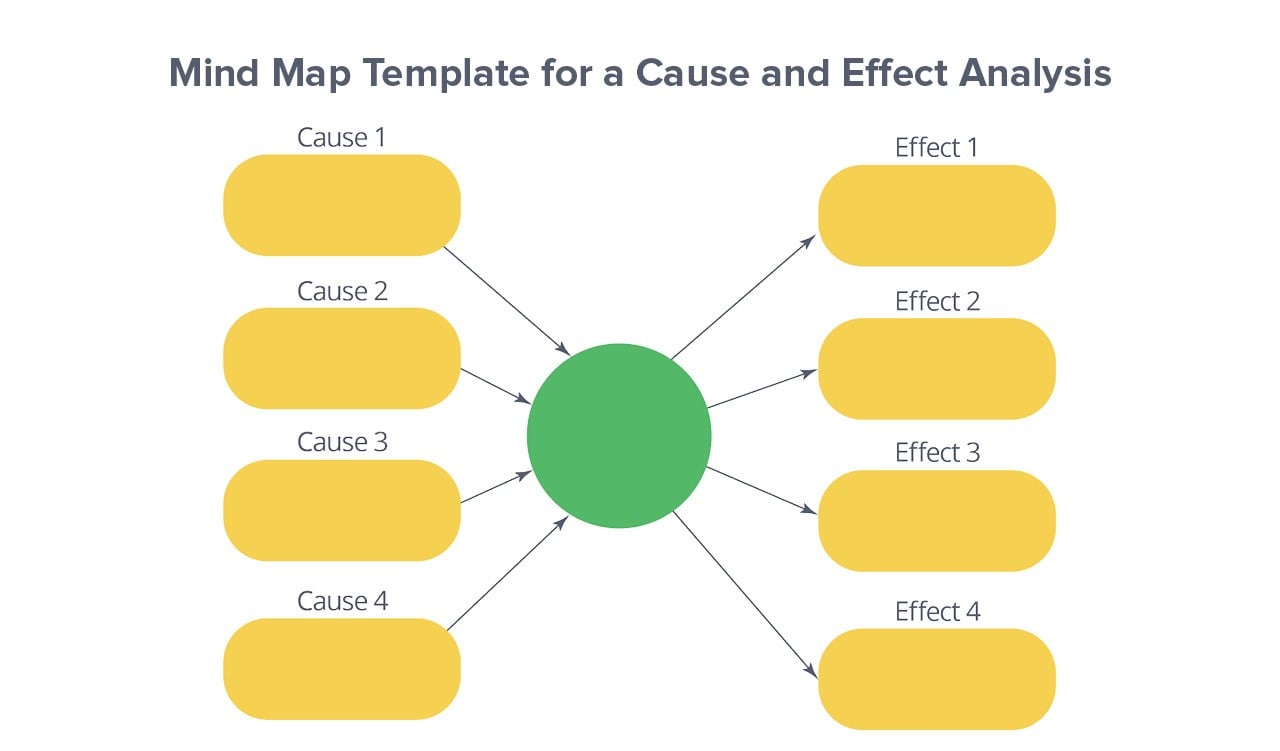
If you’ve created a mind map for your assignment and need an editing and proofreading service, we’re here to help.
Keep reading with more resources from your loyal editors and proofreaders:






